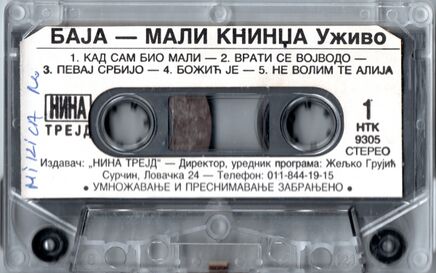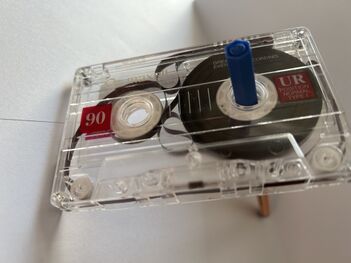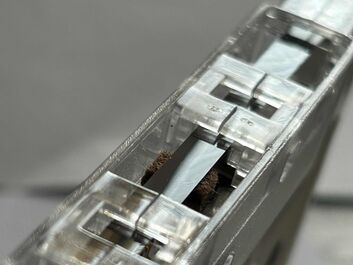I Found A Tape
Yugoslav war cassettes are some of the rarest tapes in the world, due to their limited production, disposal after the war, and lack of search efforts globally. Some of these tapes take years to find, and if you've found one, you're going to want to take good care of it.
Analog media like cassettes, VHS and vinyls play video or music as a series of magnetic pulses, or grooves pressed into a disk, not as a data stream like FLAC, MP3 or on a CD. This means a lot more can go wrong during storage and playback, and it can lead to degradation of the tape's contents. Digital content rarely degrades and only really fails when the storage medium (Hard drive or SSD) is damaged or misconfigured. Usually a digital file will either work or not work.
In contrast, analog media will degrade in different, sometimes unexpected ways, instead of failing all together. This is a blessing and a curse, because where a good sound file will be perfect studio quality (if it works), a cassette tape will still play, but much work would need to be done in post production to improve quality. High frequencies will fade, songs will not always play back the same, players can chew and damage the tape (though this is rare), or the pitch could be completely off from what it should be.
Because of their rarity you must take proper care of a tape when you find it, because you don't want them degrading further. This article will provide a basic overview of what to do when you find a tape.
Where was the tape stored?
This is the most important (controllable) factor with analog media, second only to how the tape was recorded. If your tape was found in a good environment (and remained there for a long time prior), it will likely be in better shape, and you'll hopefully get better sound quality out of it.
As soon as you find the tape, look around and see if the environment it's in is suitable for tape storage. Here are some things to avoid.
- High humidity (This will cause the physical tape to degrade and shed).
- Temperature fluctuations, even from being in sunlight (This could potentially degrade the quality of the songs on the tape).
- Magnetic fields, even ones from some electronics (This could erase things from the tape all together).
- Crushing hazards and pressure (Because a broken tape is a nightmare).
- Liquids (It's like humidity but much worse).
High humidity is the most common cause of tape degradation and its effects are very hard to treat without proper equipment. Make sure that you store the tape in a dry environment, with a temperature around 20°C (68°F). Advanced storage techniques will be detailed in "How to store a tape".
Inspecting the tape
Observing where the tape was stored will only determine if the tape should be moved to a better storage location. Inspecting the tape can help get a general idea of how the tape might sound (and if it's worth digitizing).
Once you have the physical cassette in your hands, these are the things you want to look for:
Mold
Moldy tapes will have a white texture on the tape inside the case, and is most noticeable when the tape is rewound all the way to one side. Alternatively, there may be larger spots of mold on the reel. You may also see the mold appear as a texture on the surface of the tape when it's wound over the cassette's pad.
In order to fully inspect the tape for mold, find a pencil and use it to rewind the tape by putting it through one of the reels. For rewound tapes, insert the pencil in the empty reel and rotate it so it begins dragging tape off the full reel and onto the empty reel. If the tape was paused in the middle, and there is tape on both reels, the one you turn doesn't matter. While doing this, look at each reel (or just the full reel) and make sure no spots of mold can be seen as the reels rotate. Check this on both sides of the cassette through its viewing window.
Moldy tapes are the worst case scenario, as they cannot be played without the risk of contaminating other tapes. Mold itself does not deteriorate the tape, the mold growth will get on the tape and cause it to make improper contact with the head during playback. The result is a sputtery, low quality sound that leaves mold dust behind in the player. If your tape has mold do not attempt to play it and it should be safely stored away from other tapes. There are some methods of mold removal, some offered by extremely specialized businesses, but we don't have any examples of Yugoslav tapes going through this treatment.
Mold is caused by humidity, and all tapes left in warm, moist environments will inevitably grow mold after enough time. While some mold will spin off the tape during fast forwarding and rewinding, it's not worth the damage that the mold can cause to your player or other tapes.
Sticky Shed Syndrome (SSS)
Sticky shed syndrome is another product of humidity, but it's not always directly caused by humidity. Over time, the various binders of the tape will decompose, causing the tape to begin absorbing moisture which makes the tape slightly sticky.
To check for sticky shed, put the tape in a player and fast-forward the tape until the end. After that, rewind the tape again until the beginning. When the tape is fully rewound, use a pencil to turn the full reel opposite to the the direction of playback. This will be the only way you can turn it, since the other reel is empty. Do this very carefully, as the tape can fold in on itself and cause creases. If the tape does not have sticky shed, the tape should fall off the reel with no resistance. If the tape sticks to the reel and shows up in the viewing window like it's folded into a "teardrop" shape, it likely has sticky shed.
Sticky shed can also be discovered during playback. A sticky shed tape will have inconsistent "fluttery" pitch, or will emit a high pitched ringing noise from the player, along with some high frequency distortion on the song playing. Additional things to look for during playback are covered in digitization.
Sticky shed is another very bad thing that can happen to tapes. Technically there is no "cure" for sticky shed, but you can prevent the tape from absorbing moisture by leaving it in an air-tight container with silica gel packets, or by using a food dehydrator to dry the tape out.
Ways to avoid sticky shed will be detailed in how to store a tape.
Shiny tape
Finally, a positive thing you want to look for is shiny tape. Shiny tape indicates the tape hasn't been used much, and the tape will be in very good condition as a result.
Use a pencil to wind the tape so that a section of tape can be viewed over the pad. look at this section of tape under a light source. An ideal tape will have no distortions, wrinkles, or matte areas and should cleanly reflect the light.
While the tape might look good, the music may not have been recorded onto the tape very well, and won't be in good quality either way. This does not guarantee good quality, but it does guarantee smooth playback
Digitizing and archiving
If there are no signs of sticky shed, and no signs of mold, the tape can be digitized. Digitization refers to the process of recording the tape as it's being played, so it can be copied into a digital format. Functionally the process is the same as recording sound from a microphone.
A detailed guide can be found in our article on digitizing.
Depending on the tape and its quality, digitization may not be worth the effort, especially if the tape is common and high quality audio is available.
However, a common tape may still be interesting if it was produced under a different label, or if it was a reissue from another year. Savez.net will gladly accept any documentation about your particular tape, even if it may seem redundant. We hope you will reach out through our various contact channels.
If your tape is exceedingly rare or valuable, we ask that you properly digitize it, and send us your raw, unmodified tape recording, along with scans or photos of the tape. Depending on your tape, Savez.net may perform a full restoration of your recorded audio, and the album will be returned to you digitally with enhanced quality. We will not charge you any money if we choose to restore your audio, and the restored audio will be given to you for free.
Rare tapes may be given a spot in the Ultra rare, "hall of fame" article, along with proper attribution to the tape's owner (if requested) and some of your own documentation (I.E a story of how you got it).
Though we call some tapes "valuable", Savez.net will never agree to purchase your digital audio or scans, unless you wish to sell the physical tape. No store-bought cassette is worth over $100USD, with a very limited exception for promotional or master tapes.


